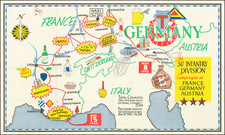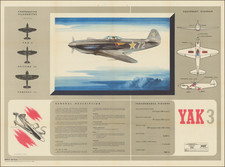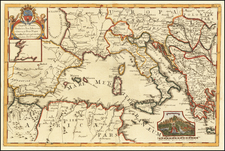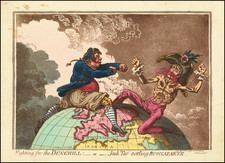Rare Czech poster celebrating the spread of Communism throughout Eastern Europe in the early 1960s.
A compelling visual portrayal of Eastern Europe is captured in this poster, with red representing the pervasive influence of Russian power across the continent, with an allegorical image representing construction, manufacturing, industry and technology. The thematic emphasis on Russian dominance becomes immediately evident, with the vast stretches of red intertwining with the European landscape, underscoring the nation's formidable presence in the region.
By 1963, Europe was deeply embedded in the Cold War era. Europe was metaphorically split by the Iron Curtain, with Eastern Europe under the influence of the Soviet Union and its communist ideology, and Western Europe aligning more with the United States and its capitalist leanings.
Czechoslovakia was a vital member of the Eastern Bloc. The country was a founding member of the Council for Mutual Economic Assistance (Comecon or RVHP in Czech, which is mentioned in the text), an economic organization comprising socialist countries and designed to promote economic collaboration and development among member nations. Founded in 1949, it served as a counterpoint to the Marshall Plan of the United States and was a tool to bind the Eastern Bloc countries economically to the USSR.
The poster, in emphasizing the economic achievements of the socialist countries, and particularly the RVHP member states, is a clear piece of propaganda. It seeks to underscore the strengths and successes of the socialist model, particularly in comparison to the "Common Market" countries, referring to the European Economic Community, which was a precursor to today's European Union.
The title "SPOLUPRACÍ KE KOMUNISMU" (Through cooperation to communism), suggests a collaborative march towards communism.
Following the title, a more detailed message is conveyed: "HOSPODÁŘSKÁ SPOLUPRÁCE ZEMÍ SOCIALISTICKÉHO SPOLEČENSTVÍ-ZÁRUKA DALŠÍHO ROZVOJE" (Economic cooperation of socialist countries - a guarantee of further development). This statement underscores the economic collaboration of socialist countries, heralding it as a guarantee for future development.
The phrase "SOCIALISTICKÉ ZEMĚ VYRÁBĚJÍ PŘES 38% SVĚTOVÉ PRŮMYSLOVÉ PRODUKCE" (Socialist countries produce over 38% of world industrial production), reveals that socialist countries account for over 38% of global industrial production and approximately 47% to the global grain harvest.
The poster concludes by spotlighting the economic growth achieved in the recent past. It states that, over the last three years, there has been a substantial rise in production within the RVHP countries: grain production has surged by 19.6 million tons, sugar beet by 10.5 million tons, milk by 3.5 million tons, and meat by 1.5 million tons.
Born in Prague on January 17, 1928, Věra Nováková's artistic journey defies simple categorization. While her prodigious talent was evident from childhood, it was challenged by the political atmosphere of the time, leading to periods of obscurity punctuated by remarkable resilience.
The formative years of Nováková were heavily influenced by the sociopolitical undercurrents of Czechoslovakia. After graduating in 1947 from a gymnasium on Resslově Street, she embarked on a brief study at the Academy of Fine Arts in Prague. However, political interference abruptly ended her academic pursuit in February 1949.
In 1950, she married Pavel Brázda, her contemporary from the academy, and resumed her studies at the Higher School of Applied Arts. After her graduation in 1952, Nováková did very little public exhibition of her artwork, largely keeping her work out of view.
After a trip to Italy in 1967, her interest in emmigration grew. The ensuing years saw her associating with the Czech dissident community, notably the Charter 77 milieu. Her underground profile continued until the early 1990s, when here work began to be more widely exhibited in Prague.
Nováková's artistic narrative is emblematic of many 20th-century European artists who grappled with political repression. Yet, what distinguishes her journey is the indomitable spirit that remained unwavering even during the darkest hours.









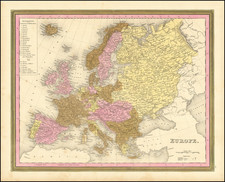
![Europa Vetus [Ancient Europe]](https://storage.googleapis.com/raremaps/img/small/82034.jpg)
